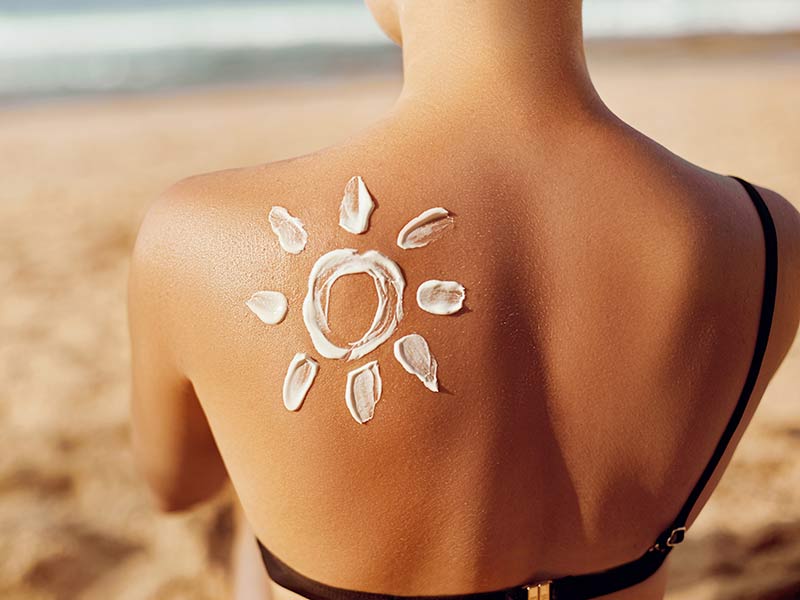

Whether you’re sunning on your balcony, doing yard work, swimming in Lake Washington, being sporty, or just taking a leisurely stroll, remember that a sunny day can be a double-edged situation. Here are some key sunscreen tips you should keep in mind to help protect your skin this summer.
What does SPF mean?
SPF is a relative measure of a sunscreen’s protection against UVB (ultraviolet B) rays, which are the kind that can cause sunburn and increase your risk of skin cancer. UV (ultraviolet) rays are a type of electromagnetic radiation that comes from the sun.
UVA rays have the longest wavelengths and can penetrate deep into the skin. They are the most common type of UV ray and are present during all daylight hours, even on cloudy days. UVA rays are responsible for skin aging and contribute to the development of some types of skin cancer.
UVB rays have shorter wavelengths than UVA rays and are the main cause of sunburn. They are most intense during the summer months, especially between 10 a.m. and 4 p.m. UVB rays also play a key role in the development of skin cancer.
What SPF should I wear?
Dermatologists recommend at MINIMUM SPF number of 15 but suggest SPF 30 or higher sunscreens for any prolonged time in the sun. You should also use a broad spectrum sunscreen to ensure sufficient UV protection for exposed skin, including on your face, ears, arms, and legs.
What kind of sunscreen should I choose?
- Although UVB rays are the most dangerous, UVA can also be damaging. Make sure that you select a sunscreen that is “broad spectrum”, meaning that it helps protect against both spectrums.
- We agree that SPF 30 is the way to go. SPF 30 helps protect against 97% of UVB rays, with higher SPFs offering slight incremental protection, but no sunscreen can protect 100%.
- SPF 15 blocks 93% of UVB rays
- SPF 30 blocks 97% of UVB rays
- SPF 50 blocks 98% of UVB rays
- Make sure it’s water resistant. You want your sunscreen to keep up with your summer activities, whether you’re running through sprinklers, working up a sweat or big time splashing.
- Make sure it’s not expired. Expired sunscreen may not provide the same amount of protection that it originally promised, so to avoid surprise sunburns, it’s best to dispose of expired sunscreen.
Application basics:
- Apply sunscreen at least 15 minutes before going outdoors.
- It takes approximately 15 minutes for your skin to absorb the sunscreen in order to provide protection. If you wait, you’re exposed and increasing the chance of sunburn.
- Keep in mind that a cloudy day doesn’t mean that the rays aren’t hitting you. If you are planning to be outside for a prolonged time during one of our famous cloudy interludes, make sure to apply sunscreen.
- Apply the right amount
- If you’re using lotion, most adults need roughly 1 oz. ( i.e. a shot glass worth). Rub the sunscreen thoroughly into your skin.
- If you’re using spray, avoid using it in a windy area, NEVER use it near an open flame, keep the nozzle close to your skin, spray until your skin glistens, and don’t forget to rub it in.
- If you’re using a stick, give the areas you need to cover 4 passes and rub it in for even coverage.
- Reapply sunscreen every two hours or immediately after swimming or sweating.
- Even water-resistant formulas aren’t as effective after prolonged exposure to moisture, so you need to reapply sunscreen frequently to maintain optimal protection.
- Towel drying also removes sunscreen, so if you plan to spend time in the sun after swimming, always add an extra layer of SPF after you get out of the water.
Wear protective clothing
In addition to wearing broad-spectrum SPF, you can minimize your UV exposure by wearing sun-protective clothing. Wearing a tightly woven long-sleeve shirt may sound counterintuitive in the summer, but the dense knit can help block UV radiation. Look for shirts and pants made from breathable, moisture-wicking material like a cotton-poly blend to help keep you cool and dry.
If It’s not covered by clothing, protect it with sunscreen.
Forgetting your ears, neck, face, tops of your feet and back of your legs could put a damper on the end of your day, and cause long term damage. Have a buddy cover hard‐to‐reach areas like your back, or use a spray sunscreen. If you have thinning hair, apply sunscreen to your scalp or wear a wide‐brimmed hat. Be a completionist by applying lip balm with a 15+ SPF.
There you have it! Some essential sunscreen tips to keep in mind this summer. Remember, most folks who get sunburned didn’t do one of the following:
- Use enough sunscreen.
- Didn’t reapply after being in the sun.
- Used expired product.
Your skin is the biggest organ on your body, so treat it with the respect it deserves.



